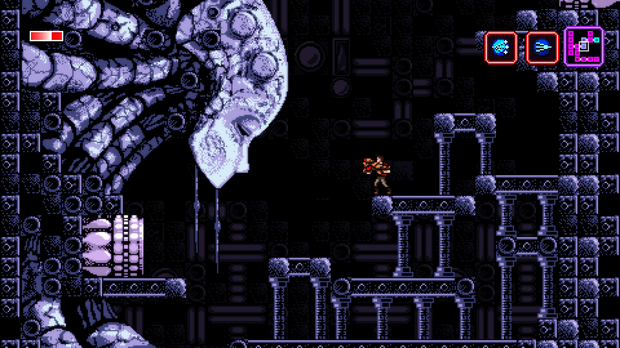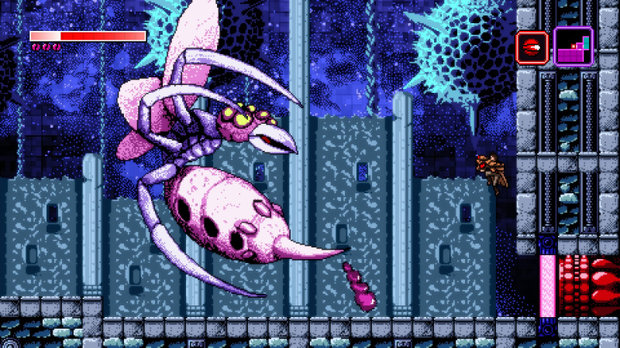Metroidvania games now comprise their own tried and true genre, including greats like Guacamelee, Shadow Complex, and the recently released Ori and the Blind Forest. They are 2D action-platformers in which you explore an expansive, interconnected map, finding new items and abilities that grant access to new areas. This is an immensely satisfying and successful formula. None of the aforementioned games, however, stick so closely to the formula established by Super Metroid as Axiom Verge. It may as well be called Super Metroid 2, which for fans of that classic, is very good news.
Games in the genre tend to at least try to find their own identity and distinguish themselves from their roots. Guacamelee, for instance, has melee-based combat and a bright, colorful art style. Ori and the Blind Forest has strong emotional cues, extremely beautiful art and music, and intensely difficult platforming and escape sequences that demand perfection. Axiom Verge never really pretends to hide its inspiration. It wears its heart on its sleeve, to the point where homage verges on plagiarism. No, you don’t play as Samus and roll around in a morph ball, but it looks and feels like you’re playing a 16-bit Metroid game. And that can’t ever really be a bad thing, can it?
You play as Trace, a scientist who accidentally blows up his lab, and instead of dying, wakes up in some alien universe that needs saving from bad guys. There are these giant A.I. robots that need to be re-powered and who claim you are the only one who can save the day and stop the big bad guy. None of it really makes any sense, but the plot is intriguing enough to spark some interest, and there are some cool twists that I won’t spoil here. It is at the very least not an exact copy of Metroid, even if it leads to a setting that feels very familiar.
Where Axiom Verge really shines is in the hardware department. The weapons, tools, and upgrades you discover are inspired and generally very cool. Early on, you get a drill that lets you dig through certain walls. You get a Nova gun that lets you shoot a projectile and then explode it when you decide. You get a Voranj gun that shoots out lasers in a branching series of veins like something out of a shmup like Blazing Lazers. You get a lab coat that allows you to transport through walls, and later you get a trench coat that allows you to transport through walls in mid-air and any direction. You get a remote spider drone that allows you to explore narrow passages you couldn’t otherwise. It’s kind of like the morph ball in Metroid, except damage received while playing as the drone doesn’t affect you, meaning you can send the drone out to scout and clear up areas for you without risking your own health.
Perhaps coolest of all is the address disruptor. Initially, it seems like a tool that lets you hack the environment and make certain walls disappear or crucial platforms appear. But you can also hack and alter all the enemies. Many enemies will be easier to kill after you use the address disruptor on them. Some enemies will even take your side after you hack them and take out other enemies for you. A select few enemies will multiply and become an even bigger pain in the ass. You have to remember to use it and experiment to see what will happen.
In fact, experimentation is key with everything you acquire, including the weapons. They are so diverse and varied that you may need to switch between them in later areas to help figure which one is most appropriate for specific situations or enemies. Areas that seem impossible may become a whole lot easier once you switch to the right weapon. I was trying to get through one particular area using the multi-disruptor (spread shot) and dying over and over. I switched to the Voranj gun and got through it no problem.
Lack of guidance and clarity can be a problem in Axiom Verge, though. While it can be fun to try out different weapons and mess with the address disruptor to see what works, navigating the world can be a chore. Too often, you will beat a boss and find a new item shortly thereafter only to dead end, uncertain as to where this new item allows you to progress. Yes, these types of games are all about backtracking and trying to figure out where to go to next, but this world can be particularly vague, which I’m sure wasn’t the intention. Scouring the entire map over and over until you somehow stumble upon the solution just isn’t fun. The funny thing is, the map isn’t even that big compared to others in the genre, but it still sucked feeling stuck just because I didn’t know where to go. Some would disagree with me, but I feel like the map would benefit from waypoints and the ability to fast travel between save points. These things should exist at least an option.
Later areas and bosses can also be frustratingly difficult and not in a good way, reeking of poor design. It’s not like the punishment and reward of games like Ori or Bloodborne, where you know failure is your fault, and you can do better next time. It just feels cheap. Like those goddamn birds in that one level in the original Ninja Gaiden. In fact, the boss battles ramp up pretty quickly into being tedious. I still feel I got lucky by beating that damn hornet boss after 20+ tries. However, despite my frustrations, I kept playing and wanting more of Axiom Verge, which is a testament to its generally clever design.
While it can be argued that lingering in the shadow of the classic that started a genre holds Axiom Verge back from greatness, I’m just happy it exists. It’s great to get something beautiful and original like Ori and the Blind Forest, but this is what I’ve really been waiting for all these years. While Nintendo is too busy with Amiibos and Animal Crossing House Decorator 2016, or whatever the hell it is they think they are doing lately, one man has spent five years crafting a pretty excellent 2D Metroid game. Sometimes I guess it takes a fan to give fans what they want, even if only in spirit.


